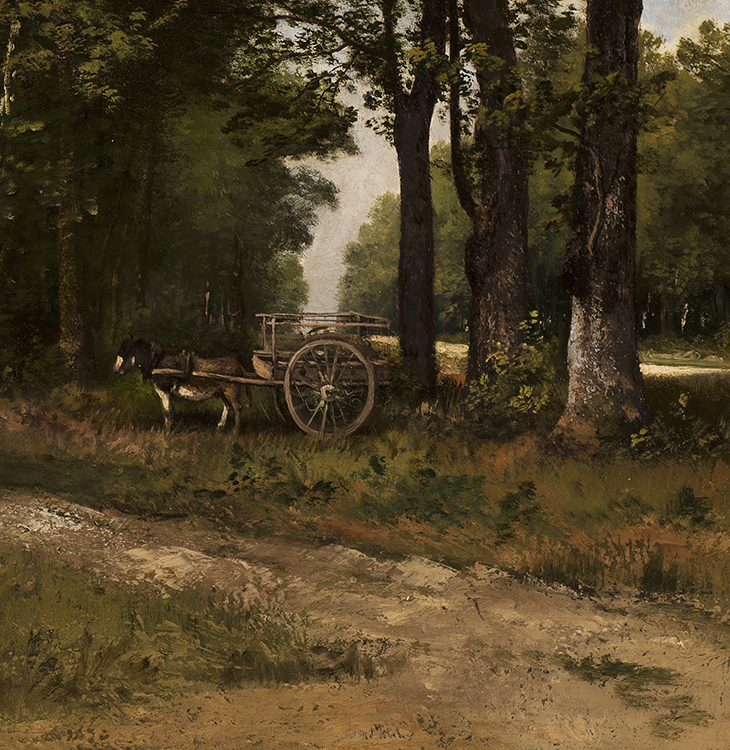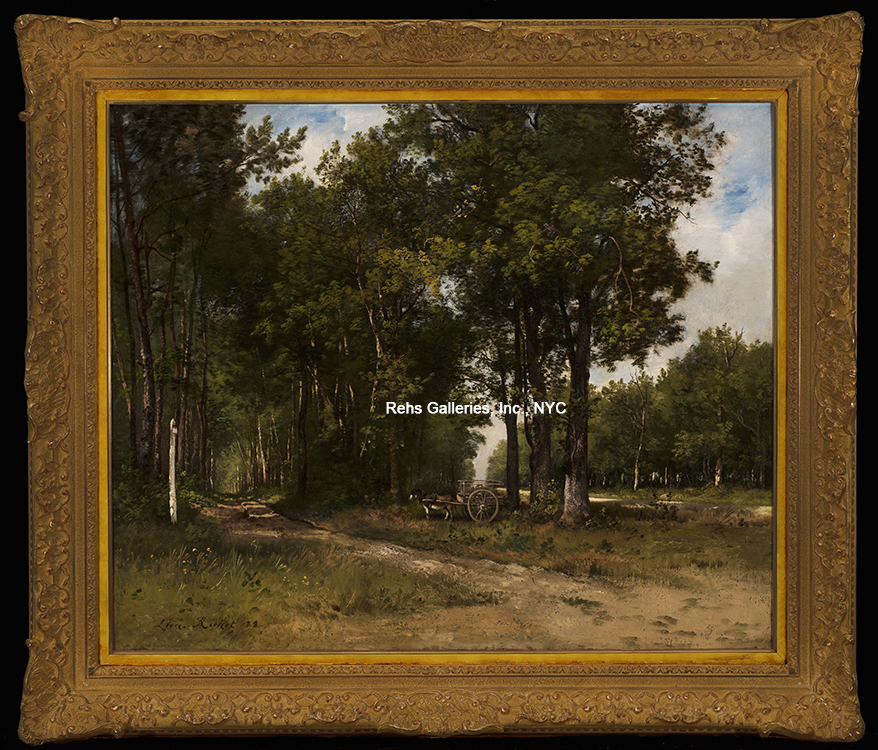Leon Richet
(1847 - 1907)
A Quiet Afternoon, Fontainebleau
Oil on canvas
23 3/4 x 29 inches
Framed dimensions:
30 1/2 x 35 1/2 inches
Signed and dated '88
BIOGRAPHY - Leon Richet (1847 - 1907)
Landscape painting was one of several prominent themes in the art of nineteenth-century France; but it was not simply the remarkable number of landscape painters that exemplified the innovative aspects of nineteenth-century landscape painting. It was instead that while the theme of nature had been treated before, it was very often an over-idealized conception of reality, seemingly acting merely a conduit for historical story telling within an artificially constructed environment. Yet, this was the accepted form of landscape painting. It was not until the nineteenth-century that a group of artists with similar ideals came together and focused on an honest treatment of the landscape in which they lived – and it was the natural landscape that was the focus of the work, its raison d’être. To construct a painting on the theme of a contemporary landscape was, in the first half of the nineteenth-century, a daring act of defiance against past traditions, many of which were governed by the official Salon and the Academic system itself. Léon Richet was among these bold artists challenging this approach, as a second-generation landscape painter who continued the legacy of the Barbizon painters.
Richet was born in Solesmes, France in 1847; the exact date of his birth is not known. He eventually became the student of three different masters: the Barbizon artist Narcisse Diaz, Jules Lefebvre, and Gustave Boulanger, an eclectic blend of inspiration that inevitably led him to follow most consistently the stylistic and thematic inclinations of Diaz, his first recorded master.
Richet debuted at the Salon of 1869 with Bouleaux sur les Hauteurs de la Plaine-Blanche, Foret de Fontainebleau (Birch Trees on the Hilltops of the Plaine-Blanche, Forest of Fontainebleau), and Mare dans la Gorge-aux-Loups, Foret de Fontainebleau (Pond in the Gorge-aux-Loups, Forest of Fontainebleau). At this time, Diaz was his only recognized master; thus, it was Diaz who had the opportunity to exert the most influence on this young and, likely, impressionable, young artist.
From his debut, Richet was already treating the subject of the French landscape, one that would remain a consistent feature of his artistic production. It was most likely under Diaz’s influence that Richet found himself painting at Fontainebleau, the small artistic enclave that had become a sanctuary for landscape artists seeking a return to the untouched and idyllic landscape - to immerse themselves in the tranquility and simplicity of country life. Yet there were several key villages surrounding this area of the forest of Fontainebleau that were home to the most recognizable names in nineteenth-century landscape painting such as Jean-Baptiste-Camille Corot, Theodore Rousseau, and Jules Dupré; most recognizable was Barbizon, which gave rise the Barbizon school of landscape painting beginning around the decade of the 1830s.
Richet, as many others, was an itinerant artist, favoring not only the area around Fontainebleau and Barbizon, but also traveling to the north of France, to the Normandy region, where many artists indulged their interests in the Norman landscape and culture. Richet’s 1870 Salon entry reflected his travels, as he exhibited Ferme en Normandie (Farm in Normandy), and Chaumières aux Environs de Tours (Cottages around Tours).
Wherever the location, the emphasis was always the same - the cottage-lined roads of the small village, the towering trees punctuating the countryside panorama, the small marsh or pond reflecting the atmospheric changes. Modern authors have commented on Richet’s “audacious…manner of treating the light and the sky in the reflection of his water.” (Gerald Schurr, 1820-1920, Les Petits Maîtres de la Peinture: valeur de demain, Paris: Éditions de l’Amateur, 1986, pg. 336). It was an opportunity for Richet and other artists to represent this era of unspoiled landscape, an era that was quickly coming to end in France with the shift towards industrialization and modernization as the end of the century neared.
The region of Picardy was another favorite locale of Richet, as his next Salon entry in 1872, the year following the end of the Franco-Prussian war of 1871 when many artists were forced to leave Barbizon, was inspired by his travels in this region. At this time, he exhibited two versions of, Près le Nouvion en Picardie (Near the Nouvion in Picardy). Richet continued submitting regularly to the annual Salon throughout the following years and until the end of his career.
While Richet’s biographical citations commonly remark upon his three masters, it was not until 1879 that he was listed as a student of all three masters, Diaz, Lefebvre, and Boulanger, ten years after debuting at the Salon, a point of interest in this artist’s career and production since the latter two artists were of a divergent style from both Diaz and Richet. Lefebvre began teaching at the Académie Julian after 1870, a progressive studio given that it allowed female students alongside males, thus it may be inferred that Richet was also a student at the Académie Julian. Such a departure in masters may be attributed to the fact that Diaz died in 1876, leaving his student Richet without artistic mentorship.
Richet benefited from the advances made by earlier landscape painters who worked consistently at establishing landscape painting as equal to the other artistic subjects, such as historical painting, which was, considered the most elevated form of painting. That early nineteenth-century landscape painting was dominated by representations of mythological or idealized representations of nature has already been commented upon, but, by the period of Richet’s Salon entries, painting the contemporary French landscape had become a more accepted them in French art. The forest itself was becoming not only the subject of artists, but of historians as well. In 1873, Paul Domet published The History of the Forest of Fontainebleau, signaling that the public was beginning to recognize the qualities that artists had, for the past decades, found in this region.
With this new understanding and sympathetic reflection towards the French countryside, Richet began earning honors at the annual Salons. His first recognition came in 1885 when he received an honorable mention. In 1888, he was awarded his first medal, third-place, for Foret de Fontainebleau – La Grande Route (Forest of Fontainebleau – The Grand Route). His final honor came in 1901 when he received a second place medal for La Seine, Près Moret – Seine-et-Marne (The Seine River Near Moret – Seine-et-Marne), and Étang dans l’Allier (Pond in the Allier).
Richet’s last Salon entry was in 1906 when he exhibited La Mare – Environs de Montargis (The Pond – Around Montargis), and Après l’Orage – Normandie (After the Storm – Normandy). By this time, he had become a member of the Société des Artistes Français and had become exempt from submitting his works for acceptance by a jury. He died in Fontainebleau the following year, 1907, on March 26th.
Richet, influenced by the tonal sentiments of his master, Diaz, as well as his Barbizon forerunners such as Theodore Rousseau, concentrated his artistic production on portraying the popular area around the forest of Fontainebleau while supplementing this with his excursions into northern France. By the time of his death in 1907, other, more avant-garde trends had come into existence and further challenged those landscape painters holding on to what remained of a type of realistic execution that, at one point in history, had been avant-garde on its own terms.
| AVAILABLE WORKS | ||




